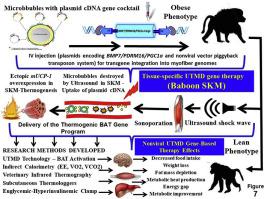Research in Veterinary Science ( IF 2.4 ) Pub Date : 2020-09-20 , DOI: 10.1016/j.rvsc.2020.09.020 Patrice A Frost 1 , Shuyuan Chen 2 , Ernesto Rodriguez-Ayala 3 , Hugo A Laviada-Molina 4 , Zoila Vaquera 1 , Janeth F Gaytan-Saucedo 1 , Wen-Hong Li 2 , Karin Haack 1 , Paul A Grayburn 5 , Ken Sayers 1 , Shelley A Cole 1 , Raul A Bastarrachea 1

|
A large number of studies have shown that the baboon is one of the most commonly used non-human primate (NHP) research model for the study of immunometabolic complex traits such as type 2 diabetes (T2D), insulin resistance (IR), adipose tissue dysfunction (ATD), dyslipidemia, obesity (OB) and cardiovascular disease (CVD). This paper reports on innovative technologies and advanced research strategies for energetics and translational medicine with this NHP model. This includes the following: measuring resting energy expenditure (REE) with the mobile indirect calorimeter Breezing®; monitoring daily body temperature using subcutaneously implanted data loggers; quantifying metabolic heat with veterinary infrared thermography (IRT) imaging, and non-viral non-invasive, tissue-specific ultrasound-targeted microbubble destruction (UTMD) gene-based therapy. These methods are of broad utility; for example, they may facilitate the engineering of ectopic overexpression of brown adipose tissue (BAT) mUCP-1 via UTMD-gene therapy into baboon SKM to achieve weight loss, hypophagia and immunometabolic improvement. These methods will be valuable to basic and translational research, and human clinical trials, in the areas of metabolism, cardiovascular health, and immunometabolic and infectious diseases.
中文翻译:

狒狒静息能量消耗、每日体温、代谢热和非病毒组织特异性基因治疗的体内测量研究方法
大量研究表明,狒狒是研究 2 型糖尿病 (T2D)、胰岛素抵抗 (IR)、脂肪组织等免疫代谢复杂性状最常用的非人类灵长类动物 (NHP) 研究模型之一。功能障碍 (ATD)、血脂异常、肥胖 (OB) 和心血管疾病 (CVD)。本文报告了采用这种 NHP 模型的能量学和转化医学的创新技术和先进的研究策略。这包括以下内容: 使用移动式间接热量计 Breezing® 测量静息能量消耗 (REE);使用皮下植入的数据记录器监测每日体温;使用兽医红外热成像 (IRT) 成像和非病毒无创、组织特异性超声靶向微泡破坏 (UTMD) 基因疗法量化代谢热。这些方法具有广泛的用途;例如,它们可能促进棕色脂肪组织 (BAT) 异位过表达的工程化mUCP-1通过 UTMD 基因治疗进入狒狒 SKM 以实现减肥、食欲减退和免疫代谢改善。这些方法对于新陈代谢、心血管健康、免疫代谢和传染病领域的基础和转化研究以及人体临床试验都很有价值。



























 京公网安备 11010802027423号
京公网安备 11010802027423号